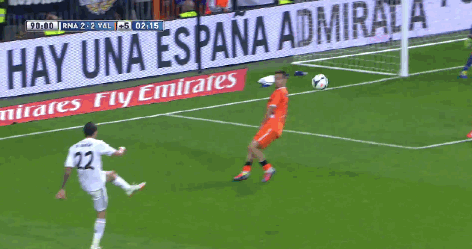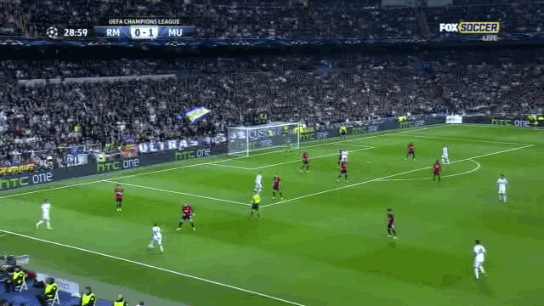![Cristiano Ronaldo]()
The USMNT stole three points that they desperately needed in a 2-1 win over Ghana.
With the win, the Yanks' chance of making it out of the "group of death" improved from 33% to 67%. But in order to get to the knockout stage, the U.S. could use at least a tie against Portugal.
A tie or a win against Portugal can happen but it involves containing the best soccer player in the world: Cristiano Ronaldo.
While Ronaldo has an injury, and there is a slight chance he won't play, the U.S. likely won't know that until hours before the game.
Business Insider asked soccer experts, some who have played in World Cups past, how the U.S. can stop Ronaldo, here's what they had to say.
Jimmy Conrad (@JimmyConrad), KICKTV host, and former World Cup defender for the USMNT :
"They can’t because he’s just too good. And because he knows, at age 29, that this will be his last chance to have a legitimate opportunity to win a World Cup before he’s on the wrong side of 30. So he’ll be incredibly motivated, but they can do these two things to slow him down:
"1. Suffocate, stifle, and hound the players that provide him the ball in dangerous areas, specifically João Moutinho, who is an incredible passer of the ball for both club (Monaco) and country (Portugal) and if the U.S. gives him the time and space to pick up his head and make passes to Ronaldo, we’re toast.
"2. Similar to how the U.S. contained Portugal’s Luis Figo, the World Player Of The Year in 2000, in the 2002 World Cup by having U.S. defender Frankie Hejduk just follow him around the field for 90 minutes, they could elect to put someone solely on Ronaldo, the 2013 World Player Of The Year, like a Timmy Chandler, for example, to play the role of pest and hope for the best."
(You can watch Conrad's preview of the Portuguese team on KICKTV here)
Jeff Agoos (@JeffAgoos), Vice President of Competition for MLS, and former World Cup defender for the USMNT:
"Every player has his own set of strengths and weaknesses. Some players have fewer weaknesses than others and Ronaldo is certainly a player with a limited number of discernible weaknesses.
"There are two ways to limit Ronaldo. Either reduce his strengths, expose his weakness or a combination of the two. Much easier said than done. Ronaldo is a player that is strongest when he has the ball and has space to run at players. Atletico Madrid did a fantastic job in the UEFA Champions League final of shutting down Ronaldo by playing a physical game with tight marking so he was unable to make runs at players. The few times Ronaldo was able to find these opportunities, Atletico Madrid brought over a second and sometimes third defender to force him to pass.
"For any talented attacking player, the key is to make the player pass the ball as much as possible and keep him as far from the goal as possible. Again, easier said than done."
Cobi Jones (@cobijones), soccer analyst, and former World Cup midfielder for the USMNT:
“With the U.S. playing with a diamond midfield and using three defensive-minded players in that formation, whatever side Ronaldo goes to, the defensive midfielder on that side will have to drift over and help double team him. It will be very important that the U.S. doesn’t give up silly fouls around the box so that no one gives him the opportunity to do his famous ‘Cristiano Ronaldo set pieces’”
Liviu Bird (@liviubird), Freelance contributor for Planet Fútbol and Sports Illustrated:
"Stopping Ronaldo will have to come by committee. Germany had a lot of success both limiting service to him and ensuring he had to go through multiple defenders anytime he was on the ball, effectively negating his dribbling ability.
"Ronaldo usually plays on the left, meaning it will come down to Fabian Johnson and Alejandro Bedoya to ensure he never gets one-on-one isolation in a dangerous area. It's something the U.S. has done well to skilled opponents in the last couple games, so it's just a matter of ensuring the fullback, winger and possibly a central midfielder are around to stymie his creativity."
John Godfrey (@jhGodfrey), Editor-in-Chief of American Soccer Now:
"I asked United States midfielder Kyle Beckerman that exact question Tuesday night in Natal, Brazil, a few minutes after the Americans defeated arch-rival Ghana, 2-1.
"His eyes got a bit wide. He exhaled theatrically. His face broke into a grin. And then he said, "I don't know. It's going to take all 11 of us."
"Fortunately, the team seems to be leaning in that direction anyway. After exploring more offensive postures over the last three years under coach Jurgen Klinsmann—mostly against weaker teams—the World Cup version of the Yanks now seem willing to hold back, defend in numbers, and try to score on quick counterattacks. In other words, this U.S. squad is doing the exact same thing past U.S. squads did in previous World Cups.
"Since Cristiano Ronaldo can score anytime and anywhere, the bunkered Americans will need to protect converted left back DaMarcus Beasley, who struggled at times against Ghana and prefers to play in a more forward position. If the defenders can overload on the left and try to nudge the well-coiffed Portuguese attacker over to the right side of the U.S. defense, the speedy and talented Fabian Johnson is much better suited to closing down Ronaldo."
But, like Beckerman said, Johnson can't be left on his own. Look for double- and triple-teaming for 90 solid minutes."
Matt Doyle (@MLSAnalyst), Senior Editor at MLSsoccer.com:
"The original idea I had - which was anything but original - was to man mark Cristiano Ronaldo. It's a regressive, relic of a soccer tactic, one that belongs back in the days of short shorts and black & white TVs. Man marking these days is almost a gimmick.
"But against Cristiano - who is the ultimate x-factor - a gimmick may be just the thing. Both Manchester United (vs. Real Madrid) and Sweden (vs. Portugal) have specifically man marked him in recent months, to good effect. and it's especially appealing to the US, since we have trouble keeping wingers out of the gaps - i.e. the goal we gave up to Ghana.
"That's where Cristiano lives. And if we let him get comfortable, this one will be over quick."
(Doyle wrote in more detail on the topic here)
SEE ALSO: Cristiano Ronaldo: How The Best Soccer Player In The World Spends His Millions
Join the conversation about this story »
 SAO PAULO (Reuters) - A street demonstration in Brazil's biggest city ended in violence on Thursday as anti-government protesters vandalized cars and banks and police responded with tear gas.
SAO PAULO (Reuters) - A street demonstration in Brazil's biggest city ended in violence on Thursday as anti-government protesters vandalized cars and banks and police responded with tear gas. The 32 countries competing in the World Cup qualified from a selection process involving 204 national teams, with the exception of hosting nation Brazil – they had a secured spot. “The countries’ combined population covers a sizeable proportion of the global population – approximately 1.9 billion people out of a world population of around 7.3 billion people,” said Amlan Roy, Head of Global Demographics and Pension Research at Credit Suisse. “From an economic point of view, these 32 countries account for a combined gross domestic product (GDP) of $47 trillion.” Credit Suisse’s recent study “
The 32 countries competing in the World Cup qualified from a selection process involving 204 national teams, with the exception of hosting nation Brazil – they had a secured spot. “The countries’ combined population covers a sizeable proportion of the global population – approximately 1.9 billion people out of a world population of around 7.3 billion people,” said Amlan Roy, Head of Global Demographics and Pension Research at Credit Suisse. “From an economic point of view, these 32 countries account for a combined gross domestic product (GDP) of $47 trillion.” Credit Suisse’s recent study “





















 Name: Cristiano Ronaldo
Name: Cristiano Ronaldo

















